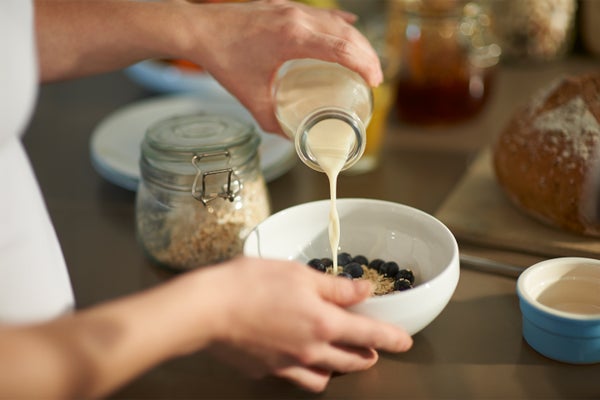Pasteurization Kills Bird Flu Virus in Milk, New Studies Confirm
Flash pasteurization destroyed H5N1 viral particles that were highly concentrated in raw milk, confirming that standard techniques can keep dairy products safe from bird flu

Dougal Waters/Getty Images
Pasteurization—the process of using high heat to eliminate harmful microbes in foods—effectively kills the H5N1 avian influenza virus that is currently circulating in U.S. cattle. In a new study scientists at the Food and Drug Administration and U.S. Department of Agriculture pasteurized raw milk inoculated with high concentrations of the pathogen and found that the treatment inactivated it in all samples. The finding validates that this century-and-a-half-old technique can protect humans from infectious microbes. Both agencies recommend that people should not consume raw (unpasteurized) milk or raw milk products.
Concerns over the safety of dairy products have risen with reports of bird flu outbreaks at dairy cow farms in multiple states. As of June 28, there have been three human cases of avian flu in the U.S. this year, according to the Centers for Disease Control and Prevention. All identified cases were in dairy farm workers who had direct contact with infected cattle. The FDA and USDA had previously sampled retail dairy products that had been commercially pasteurized, about 20 percent of which contained H5N1 viral particles. None of the 297 samples—which came from 132 processing sites in 38 states and were collected from April 18 to 22—contained live infectious virus, however. (The results of the sampling study were initially released in May, prior to its upcoming publication in the Journal of Virology.)
The most common commercial dairy treatment process is high-temperature short-time (HTST) pasteurization, also called “flash pasteurization,” which involves rapidly churning raw milk through large tanks at a temperature of at least 161 degrees Fahrenheit (72 degrees Celsius) for approximately three to 15 seconds before it’s cooled. This kills most harmful pathogens, including bacteria and viruses. The new pasteurization study, which the FDA released on its site on June 28, replicated real-world pasteurization conditions to see how effective the process is at killing the currently circulating H5N1 strain in milk. The paper has been submitted to the Journal of Food Protection but has not yet been published.
On supporting science journalism
If you’re enjoying this article, consider supporting our award-winning journalism by subscribing. By purchasing a subscription you are helping to ensure the future of impactful stories about the discoveries and ideas shaping our world today.
The researchers collected raw milk samples from farms in states with known outbreaks. The average concentration of viable H5N1 in positive samples was about 3,000 viral particles per milliliter. The team then artificially contaminated homogenized, raw whole milk with even higher viral concentrations—about five million viral particles per milliliter—and treated the samples in a HTST continuous-flow pasteurization system similar to those used by the dairy industry. The system pumped the milk through two heating chambers: the first preheated it to 100 degrees F (38 degrees C), and the second brought it to 162.5 degrees F (72.5 degrees C) before holding it in a tube at 161 degrees F (72 degrees C). After about 15 seconds of that high heat, the liquid was transferred to a separate tank to cool.
Pasteurization completely inactivated the virus in all of the tested samples. This was true even when the team checked on the milk midway through the process, before it went into the holding tube. The researchers predict that pasteurization may be effective at killing as many as one trillion viral particles per milliliter.
“Validating the effectiveness of the pasteurization parameters critically demonstrates that commercial milk processing is capable of controlling the … virus and further provides broad assurance that pasteurized milk and dairy products made from pasteurized milk are safe,” said Nathan Anderson, a co-author of the study and director of the Division of Food Processing Science and Technology at the FDA’s Center for Food Safety and Applied Nutrition, in a recent press release.
At last week’s meeting of the CDC’s Advisory Committee on Immunization Practices, agency researchers presented an update on the state of avian influenza surveillance in the U.S. Data so far indicate that the risk of H5N1 infection in the general public is low. But the CDC recommends people who come into close, prolonged contact with infected animals should take safety precautions, such as wearing a face mask, a face shield or goggles and disposable coveralls. The agency says its scientists are actively monitoring the situation and collaborating with the FDA, the USDA and state public health departments. Currently H5N1 has been detected in cattle in 132 dairy herds across 12 states.
H5N1 isn’t a new threat; it’s been present in bird populations since 1996. The pathogen has since been detected in a growing number of mammals, including cats, dogs, goats and seals. The currently circulating version of the virus emerged in 2020 from migratory wild aquatic birds, first resulting in outbreaks in poultry in 2022 before being detected in cattle this year. Avian flu viruses have caused periodic outbreaks in humans, with a high mortality rate. The current strain does not yet appear to transmit easily from person to person, but the more it spreads, the greater the chances are that it will adapt to humans and cause a wider outbreak.
























































